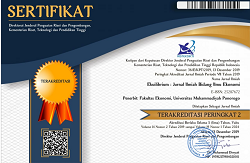GLOBALIZATION AND ITS IMPACT ON ECONOMIC GROWTH: EVIDENCE FROM ASEAN COUNTRIES
DOI: 10.24269/ekuilibrium.v14i2.2019.pp104-119
Abstract
The economic growth in ASEAN countries increases and develops in each year. globalization has a positive effect on economic growth through the effectiveness of the allocation of domestic resources, technological diffusion, increased productivity and capital. This study investigates globalization to economic growth in ASEAN in 2012-2017. The research method used judgmental sampling with samples of 11 countries. They were Brunei Darussalam, Cambodia, East Timor, Indonesia, Lao PDR, Malaysia, Myanmar, Philippines, Singapore, Thailand, and Vietnam. The analysis used path analysis to examine each variable. Globalization was determined by globalization index, economic globalization, social globalization, and politic globalization. Real Gross Domestic Product (GDP) and Gross Domestic Product (GDP) per capita are used as proxy for economic growth. The results describe that globalization had a significant positive association with economic growth. All indicators of globalization, show the positive association between globalization index, economic globalization, social globalization, and politic globalization to real Gross Domestic Product (GDP) and Gross Domestic Product (GDP) per capita. This confirms that globalization is able to provide a positive response in ASEAN.
Keywords
References
- Borensztein, E., J. De Gregorio, and Lee, J-W. 1998. How Does Foreign Direct Investment Affect Economic Growth?. Journal of International Economics 45: 115-135.
- Dreher, A. 2006. Does Globalization Affect Growth? Evidence from a New Index of Globalization. Applied Economics 38(10): 1091–1110. DOI: 10.1080/00036840500392078.
- Ghozali, Imam and Hengky Latan. 2015. Partial Least Squares concepts, techniques and applications Using SmartPLS 3.0 Program. Semarang: Diponegoro University Publishing Agency p. 76-77.
- Hair, Joseph E, Jr. et al. 2014. A Primar Of Partial Least Squares Structural Equation Modeeling (PLS-SEM). Sage Productions, Inc. California. Usa p. 44. Accessed August 2018
- Hamdi, Fairooz Mustafa. 2013. The Impact of Globalization in the Developing Countries. ISSN 2224-607x (Paper). ISSN 2225-0565 (Online). Www.Iiste.Org 3 (11) : 142-144. Accessed August 2018.
- Rao, Bb., and Vadlamannati, K.C. 2011. Globalization and Growth in the Low-Income African Countries with the Extreme Bounds Analysis. Economic Modelling 28: 795–805. DOI: 10.1016/j.econmod.2010.10.009.
- Samimi P and Jenatabadi H. 2014. Globalization and Economic Growth: Empirical Evidence on the Role of Complementarities. Www.Plosone.Org 9 (4): 1-7. DOI:10.1371/Journal.Pone.0087824.
- Suci, Stania C. et al. 2015. The Impact of Globalization to Economic Growth in ASEAN (Dampak Globalisasi Terhadap Pertumbuhan Ekonomi di ASEAN). International Journal of Administration and Organization. 2 (2): 79-87.
- The World Bank, Available at: http://www.worldbank.org/unite nations/. Accessed September 2018.
- The Association of Southeast Asian Nations (ASEAN), Available at: https://asean.org/asean/about-asean/overview/. Accessed September 2018.
- Wolf, Martin. 2004. Globalization And Interdependence. New Haven: Yale University. Available at: http://www.un.org/esa/documents/un.oct.2004.globalisation.and.interdepence.pdf. Accessed September 2018.
- Ying, et al. 2014. The Impact of Globalization on Economic Growth. Romanian Journal of Economic Forecasting 17 (2): 25-34.
Refbacks
- There are currently no refbacks.

This work is licensed under a Creative Commons Attribution-ShareAlike 4.0 International License.














